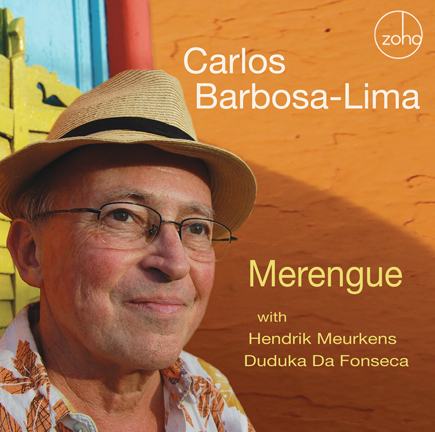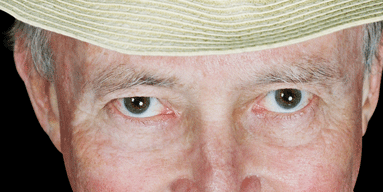|
Carlos Barbosa-Lima
Merengue
Release Date: November 10, 2009
Selection #: ZM 200911
UPC Code: 880956091129
Availability: Worldwide
Songs:
1. INVOCATION TO XANGO 3:27
2. MERENGUE 1:45
3. VELEIRO 2:48
4. MODINHA 4:02
5. BATUQUE 2:14
6. CAMINHO DE PEDRA 2:53
7. EL MARABINO 2:46
8. SEIS POR DERECHO 3:09
9. PRELUDE No. 2 3:06
10. SEIS MILONGA 5:23
11. DANZA DEL ALTIPLANO 3:03
12. GUAJIRA CRIOLLA 2:49
13. CAJITA DE MUSICA 2:26
14. CANHOTO 3:00
15. IMPLICANTE 3:03
16. CANCION CARORENA 2:59
17. PAIS DE ABANICO 3:40
18. NUNCA TE OLVIDO 5:38
19. ESCORREGANDO 2:44
20. FANTASY ON A HAWAIIAN LULLABY 6:00
|
Musicians:
CARLOS BARBOSA - LIMA guitar
GUSTAVO COLINA - cuatro on # 2, 7, 8
HENDRIK MEURKENS - harmonica on # 4, 8
MARCILIO LOPES - mandolin on # 14, 15
DUDUKA DA FONSECA - percussion on # 1, 14, 15, 19
GEORGE ANDERSON - bass on # 1
GUITAR TRIO
(C. Barbosa-Lima, Karin Schraupp, Christopher McGuire)
on # 1, 3, 19
Producer - HEINER STADLER
|
 |
|
On Merengue, his fifth ZOHO CD, guitarist Carlos Barbosa-Lima takes an adventurous musical journey through Ibero-America, including his native Brazil, performing music by renowned composer-guitarists of Latin-America and Hawaii. Carlos invited as special guests Hendrik Meurkens (U.S.) on harmonica, Duduka Da Fonseca (Brazil) on percussion, Gustavo Colina (Venezuela) on cuatro, Marcilio Lopes (Brazil) on mandolin, and George Anderson (U.S.) on bass. “Merengue” also features the debut recording of the “World Guitar Trio”, with Barbosa-Lima joined by guitarist Karin Schaupp (Australia) and Christopher McGuire (Texas).
Barbosa-Lima’s career as concert guitarist has run uninterruptedly for over fifty years. He has recorded over fifty albums, initially for Chanteclair and Concord Records –now regrettably deleted- and since 2000 for ZOHO. Many composers, including Ginastera, Mignone, Santórsola, Cordero, Scott and Yasui, have written pieces for him, thus significantly enlarging the guitar literature. His imaginative concert programs have broken down the worn-out dichotomy between popular and classical music. Tt is therefore only just, in my humble opinion, to define Maestro Carlos Barbosa-Lima as a living legend!
Invocation to Xango has Afro-Brazilian influences with a ritualistic, festive spirit, composed by Radamés Gnattali (1906-1988). Gnattali wrote extensively for guitar, and “Xango” is part of his “Suite Popular Brasileira” for guitar and piano, here arranged for guitar trio by Laurindo Almeida. The fiery performance of the guitars is enhanced by Duduka Da Fonseca’s percussion and George Anderson’s acoustic bass, making a strong start of this journey.
Merengue is a traditional Venezuelan dance in 5/8, different from the Dominican Republic’s contemporary Merengue in 4/4. Its author Rodrigo Riera (1923-1999) was a talented Venezuelan guitarist and composer. During the 1960s, he lived in New York City where he wrote his most known works.
Veleiro (“Sailboat”) is a theme from “Forest of the Amazon”, a symphonic poem for orchestra, Heitor Villa-Lobos’ (1887-1959) last work. It was premiered in July 1959 in New Jersey. The orchestra was conducted by the composer who died in November of that same year. “Veleiro” suggests the water motion while sailing the Amazon River.
The Harmonica became a popular instrument in Brazil in the early 20th century. In “Modinha” by Antonio Carlos Jobim (1926-1994), the harmonica has a nostalgic, singing quality. The guitar gives harmonic support and interacts with the harmonica’s melodic lead. Brazilian guitarist-composer Laurindo Almeida (1917-1995) achieved international acclaim in Brazil, moving to Los Angeles in 1947. “Batuque” (Baa-too-kee) was inspired by ritual dances of Brazil’s northeast. Barbosa-Lima arranged this version, wrote the introduction and some bridges throughout the piece, giving it a jazzy flavor.
Caminho de Pedra (“Rocky Road”) is an early Jobim song distinguished by its evocative character. This version has wonderful dialogues between harmonica and guitar.
Antonio Lauro (1917-1986), one of the most important Latin American composers, was a fine guitarist who wrote extensively for his instrument, always inspired by Venezuelan folk styles. He was born in the colonial city of Angostura, today named Ciudad Bolivar. His guitar compositions include “valses” and “joropos”, frequently crossing ? and 6/8 rhythms. “El Marabino” refers to a native of Maracaibo, where Lauro lived for a time. Colina adds creative improvisations with his cuatro.
Seis por Derecho is a joropo, an up-tempo dance typical of the Venezuelan prairies called “llanos”. It’s a virtuoso solo guitar piece, with brilliant participation of the cuatro, played by Colina.
Heitor Villa-Lobos’ compositional legacy for guitar is one of the most significant of all times. His Prelude no. 2 has an urban character in the first part. In its second section, it enters a world of exciting Afro-Brazilian drive, with parallel movements of arpeggiated chords bringing a wide sonorous dimension. Afterwards it returns to the lyrical and festive ambience of the first part, leading to a grand finale.
Seis Milonga is the last movement of my “Suite Antillana”. It evokes the atmosphere of the Spanish speaking Greater Antilles islands Cuba, Puerto Rico and the Dominican Republic. Seis Milonga is a Puerto Rican/Argentinean dance, written in 1980, revised and expanded in 1999, dedicated to my dear, admired friend Carlos!
Cuban composer Leo Brouwer, born in 1939, has written major works for guitar, including concertos, chamber and solo works. He has also re-created many popular themes, always giving them a personal touch. Danza del Altiplano is inspired by folkloric music of the Andes and routed in the Inca tradition. Guajira Criolla is a tasteful arrangement by Brouwer of the song “El arroyo que murmura”, written by Cuban composer Jorge Anckerman. In this guajira, a typical style of Cuban rural areas, Brouwer uses counter-lines enriching the melodies with pizzicati on the basses.
|
 Cajita de Música (“Music Box”) was written by Isaias Savio (1900-1977), Uruguayan composer, pedagogue and guitarist. He was the teacher of Carlos Barbosa Lima, Luis Bonfá, and Paulo Bellinati, among others. He wrote more than 200 works for guitar, didactic works and many transcriptions and arrangements. Cajita de Música (“Music Box”) was written by Isaias Savio (1900-1977), Uruguayan composer, pedagogue and guitarist. He was the teacher of Carlos Barbosa Lima, Luis Bonfá, and Paulo Bellinati, among others. He wrote more than 200 works for guitar, didactic works and many transcriptions and arrangements.
Gnattali wrote Canhoto, a charming piece with a choro flavor, named after his friend, a left-handed guitarist. Da Fonseca gives occasional percussive touches, like someone listening in on a conversation between two people and getting in for a moment. Marcilio Lopes, one of the leading mandolin players in Brazil, wrote this arrangement for mandolin and guitar. - The mandolin has had an important role in Brazilian music since the 1950s. It found greater acceptance after the rise of composer Jacob do Bandolin who wrote many works in the choro style. Implicante was brilliantly arranged by Lopes for mandolin, Barbosa-Lima on guitar, and percussionist Da Fonseca.
Canción Caroreña is a tribute by its author Rodrigo Riera to the state of Carora, Venezuela, where he was born. It’s a song of haunting lyricism, with a rich use of polyphony and harmony on the guitar.
The great guitar virtuoso Agustín Barrios Mangoré (1885-1944) was born in San Juan Bautista de las Misiones, Paraguay and died in El Salvador. He wrote more than 200 works for guitar, always emphasizing the musical heritage of Latin America. Barrios had an extensive concert career until settling in El Salvador where his health started to decline. “Pais del abanico” (“Country of the Fan”) was inspired by the artwork on a hand-fan. Barbosa Lima has played Barrios’ music since the beginning of his concert career.
Gentil Montaña, born in 1942, is a talented composer and guitarist, inspired in the musical traditions of his country Colombia. “Nunca te olvido” (“I never forget you”) is a dance of exquisite lyricism and inventive harmonies.
Escorregando (“Sliding”) was written by Ernesto Nazareth (1863-1934), one of the most important Brazilian composers. He integrated European forms with Afro-Brazilian rhythms in the late 19th century, such as the “maxixe”. In fact, Nazareth was establishing the foundations for a new genre which was eventually defined as “choro”. In the 20th century, they became the most popular instrumental music of Brazil. Barbosa-Lima arranged this piece for guitar trio, here played by the “World Guitar Trio”. Da Fonseca adds his percussive skills to this work.
Hawaiian composer Byron Yasui was born in Honolulu in 1940. He has written many works for orchestra, chamber music and solo instruments, in a wide range of styles. He met Barbosa-Lima in 1977 and has since developed a great interest in the guitar. Fantasy on a Hawaiian Lullaby is a series of variations based on “Pupu Hinu Hinu” by Nona Beamer. The song describes a boy and a girl at the beach, listening to ocean sounds through a conch shell; afterwards they fall asleep and start a pleasant dream enjoying nature’s wonders.
Congratulations, Carlos, on this new CD full of musical surprises, innovative arrangements and brilliant guitar playing - it is one of your best! Definitively, Carlos resembles great wine which also matures and gets better with the passage of time.
Ernesto Cordero
July 1, 2009
Solo guitar recorded at PRT Studio, Puerto Nuevo, Puerto Rico, in June 2008. Recorded by Pedro Rivera Toledo. Additional solo guitar recorded by Malcolm Addey at MALCOLM ADDEY STUDIO B, New York, NY in April 2009. Digital editing by Kevin Siwoff, May 2009.
Further recordingsat Maverick Recording, New York, NY in April and June 2008. Recorded by Allen Farmelo. Estudio Umuarama, Rio de Janeiro, Brazil, in March 2008. Recorded by Ricardo Calafate. Acoustic Plus, Dallas, TX, in May 2008. Recorded by Gerald Jones. – Remixed and mastered by Malcolm Addey at MALCOLM ADDEY STUDIOS, New York, NY, in April – June 2009.
|
|
|
|

